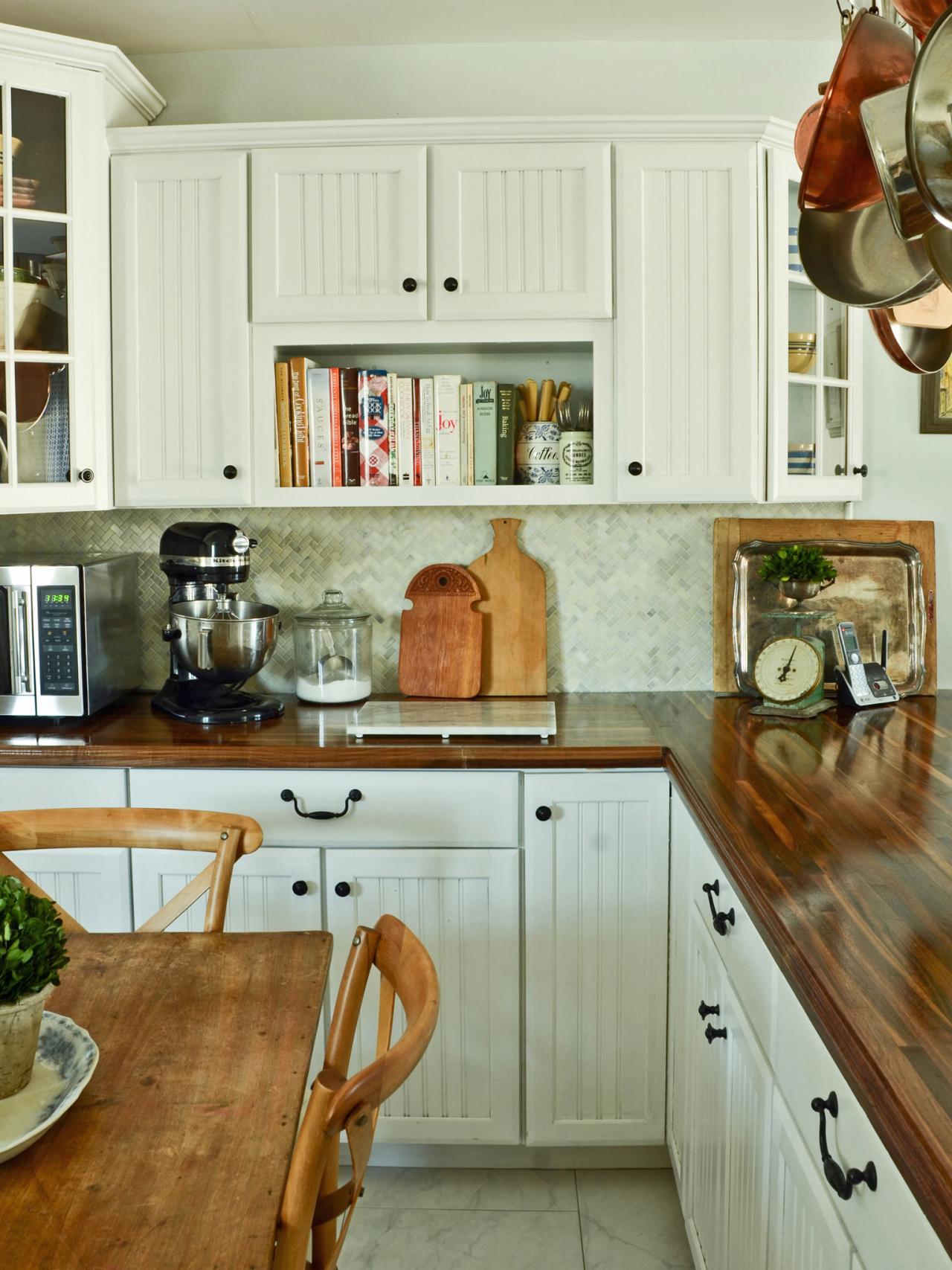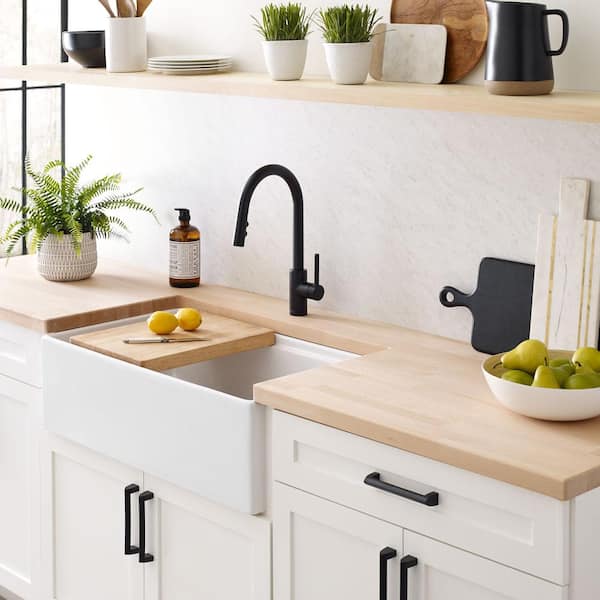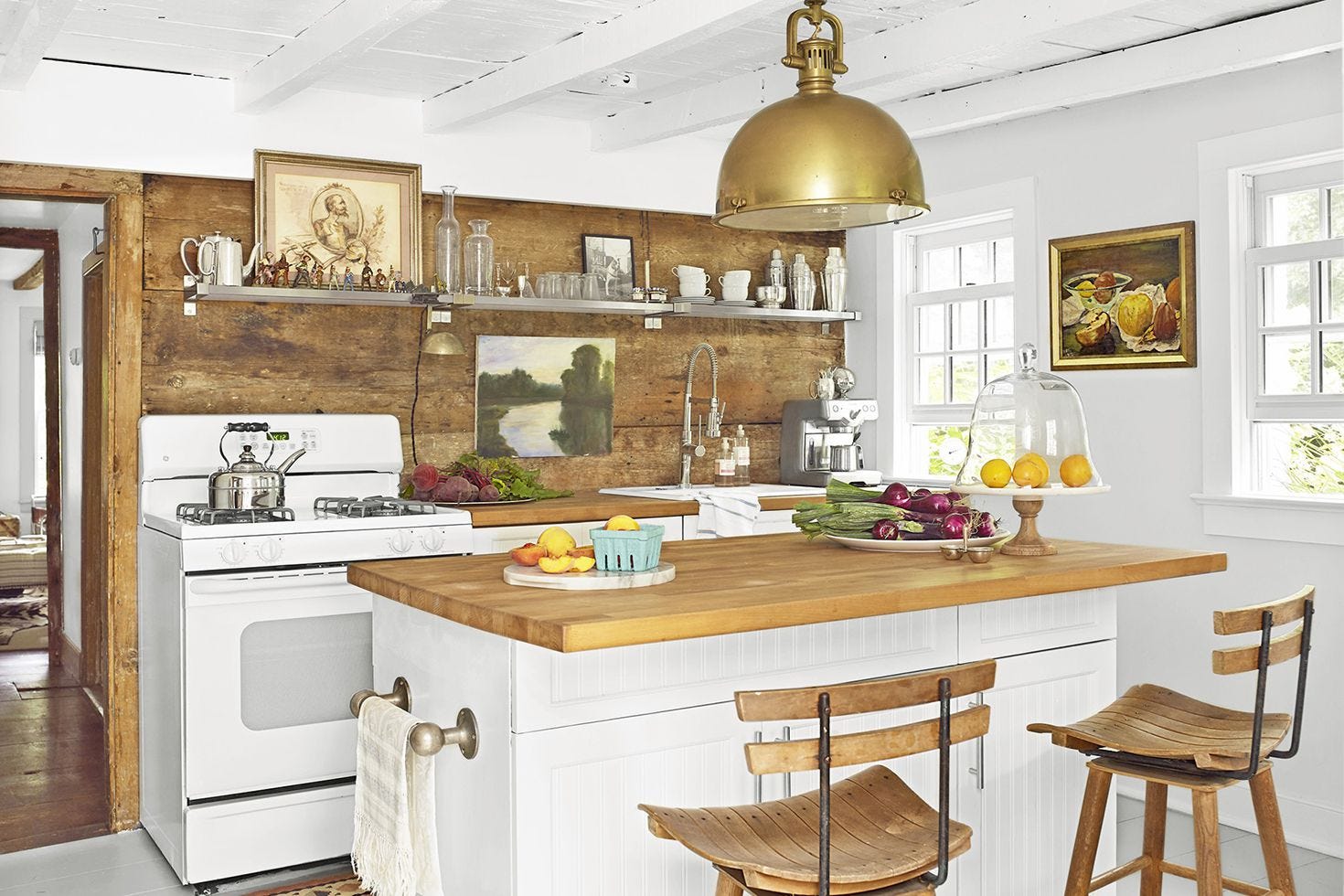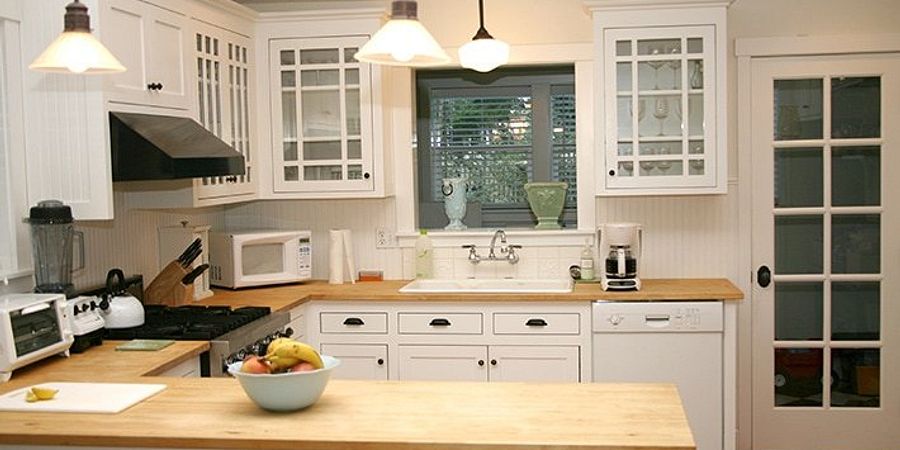Butcher block countertops paired with white cabinets create a warm, inviting, and timeless kitchen aesthetic that blends rustic charm with modern simplicity. The natural wood grain of butcher block countertops provides a striking contrast to the crisp, clean look of white cabinets, adding texture and warmth to the space. This combination works well in a variety of kitchen styles, from farmhouse to contemporary, and offers a versatile canvas for further personalization.
Butcher block countertops are made from straight cuts of wood glued together into thick slabs. The wood can come from various species, each offering different colors and grain patterns. Popular choices include maple, walnut, oak, and cherry, each providing unique aesthetic and functional benefits. Maple, for example, is light-colored and extremely durable, making it a popular choice for busy kitchens. Walnut offers a rich, dark color that can create a luxurious contrast with white cabinets. Oak and cherry provide a middle ground with warm, reddish tones that add a cozy feel to the kitchen.
One of the primary advantages of butcher block countertops is their natural beauty. The wood grain patterns and color variations create a unique and organic look that synthetic materials can’t replicate. When paired with white cabinets, the natural warmth of the wood stands out even more, creating a balanced and inviting atmosphere. This combination works particularly well in kitchens with plenty of natural light, as the sunlight enhances the wood’s natural luster and the white cabinets’ brightness.
In terms of functionality, butcher block countertops are highly versatile. They can be used as a cutting surface, eliminating the need for separate cutting boards. However, this functionality requires regular maintenance to keep the surface sanitary and in good condition. Regular oiling is essential to prevent the wood from drying out and cracking. Additionally, butcher block countertops can be sanded down to remove stains, scratches, and other signs of wear, making them a durable and long-lasting option.

The warmth of wood complements the cool, neutral tone of white cabinets, making this pairing suitable for various design styles. In a farmhouse kitchen, for example, butcher block countertops enhance the rustic, homey feel, especially when combined with vintage-inspired fixtures and accessories. In a modern kitchen, the wood adds an element of nature and warmth, softening the sleek lines and glossy finishes typically associated with contemporary design. This versatility makes butcher block countertops a popular choice for homeowners looking to create a kitchen that feels both timeless and personalized.
When considering butcher block countertops with white cabinets, it’s important to think about the overall color scheme and materials used in the kitchen. The natural tones of the wood can complement a variety of colors and finishes, but it’s essential to ensure that the other elements in the kitchen, such as the backsplash, flooring, and appliances, harmonize with the wood and white cabinets. For instance, a neutral or light-colored backsplash can enhance the bright and airy feel of the kitchen, while darker or more vibrant colors can create a bold contrast.
In addition to their aesthetic appeal, butcher block countertops offer practical benefits. They are relatively affordable compared to other countertop materials like granite or quartz. This makes them an attractive option for budget-conscious homeowners who still want a high-quality, stylish kitchen. Additionally, the installation process for butcher block countertops is generally straightforward, which can help reduce labor costs.

However, butcher block countertops do require regular maintenance to keep them looking their best. Unlike stone or laminate countertops, wood is susceptible to moisture and can stain or warp if not properly cared for. Regular oiling is necessary to maintain the wood’s moisture balance and protect it from water damage. Additionally, spills should be wiped up promptly, and it’s advisable to use trivets or heat pads to protect the surface from hot pots and pans.
Despite the maintenance requirements, many homeowners find that the benefits of butcher block countertops outweigh the drawbacks. The unique beauty and warmth of wood, combined with the clean, classic look of white cabinets, create a kitchen that is both functional and aesthetically pleasing. With proper care, butcher block countertops can last for many years, developing a rich patina over time that adds to their charm and character.
Butcher block countertops also offer an eco-friendly option for kitchen surfaces. Many manufacturers use sustainably sourced wood or reclaimed wood, reducing the environmental impact of production. Additionally, wood is a renewable resource, and the countertops can be recycled or repurposed at the end of their lifespan, contributing to a more sustainable kitchen design.
Another advantage of butcher block countertops is their ability to be customized. They can be cut to fit any kitchen layout and can be finished with various edge profiles, from simple square edges to more decorative ogee or beveled edges. This customization allows homeowners to tailor their countertops to their specific design preferences and needs, ensuring a perfect fit in their kitchen.

In terms of design flexibility, butcher block countertops can be stained or finished in a variety of ways to achieve different looks. For instance, a clear finish can highlight the natural beauty of the wood, while a darker stain can create a more dramatic contrast with white cabinets. This versatility allows homeowners to create a kitchen that reflects their personal style and complements the overall decor of their home.
The tactile quality of butcher block countertops is another appealing feature. The smooth, warm surface of the wood provides a pleasant contrast to the harder, cooler surfaces typically found in kitchens, such as tile and stainless steel. This tactile quality can make the kitchen feel more inviting and comfortable, enhancing the overall cooking and dining experience.
Additionally, butcher block countertops can be paired with various types of white cabinets to achieve different looks. For example, shaker-style cabinets with their clean lines and simple design can complement the natural beauty of the wood, creating a timeless and classic kitchen. More ornate or traditional cabinet styles can add a touch of elegance and sophistication, while sleek, modern cabinets can create a contemporary and stylish space.

Common Mistakes to Avoid
Neglecting Maintenance: Butcher block countertops require regular oiling to prevent the wood from drying out and cracking. Failing to maintain the countertops can lead to damage and a shorter lifespan.
Ignoring Moisture Issues: Wood is susceptible to water damage. Spills should be wiped up promptly, and it’s essential to avoid leaving wet items on the countertop for extended periods.
Using the Surface Improperly: While butcher block countertops can be used as a cutting surface, doing so regularly can lead to deep scratches and knife marks. Using cutting boards for heavy-duty chopping can help preserve the surface.
Not Considering Color Coordination: The natural tones of the wood should harmonize with other elements in the kitchen. Clashing colors or finishes can disrupt the cohesive look of the space.
Overlooking Heat Protection: Placing hot pots and pans directly on the wood can cause burns and scorch marks. Always use trivets or heat pads to protect the countertop.
Choosing the Wrong Wood Species: Different wood species have different hardness levels and appearances. Selecting a wood that doesn’t match your usage needs or aesthetic preferences can lead to dissatisfaction with the countertop.

How do I maintain butcher block countertops to ensure their longevity?
Maintaining butcher block countertops involves regular oiling to keep the wood moisturized and prevent drying and cracking. Mineral oil is commonly used for this purpose, but other food-safe oils like walnut oil can also be effective. Depending on usage, oiling might be necessary once a month or more frequently. Additionally, it’s important to wipe up spills immediately to prevent stains and water damage. Using cutting boards for heavy chopping and trivets for hot items will help protect the surface from scratches and burns. Sanding the surface periodically can remove any minor scratches and restore the wood’s smooth finish.
Can butcher block countertops be used as a cutting surface?
Yes, butcher block countertops can be used as a cutting surface, but it’s important to do so with care. Regular cutting directly on the countertop can lead to deep knife marks and scratches, which can harbor bacteria and be difficult to clean. Using a separate cutting board for heavy-duty chopping is recommended to preserve the countertop’s appearance and hygiene. If the surface does become scratched, it can be sanded down and refinished to restore its smoothness and appearance.
What are the benefits of pairing butcher block countertops with white cabinets?
Pairing butcher block countertops with white cabinets creates a warm, inviting, and timeless kitchen aesthetic. The natural warmth of the wood contrasts beautifully with the crisp, clean look of the white cabinets, adding texture and depth to the space. This combination works well in a variety of kitchen styles, from farmhouse to contemporary, and provides a versatile canvas for further personalization. The wood’s natural grain patterns and variations add unique character, while the white cabinets keep the overall look bright and fresh.

How do I protect butcher block countertops from water damage?
To protect butcher block countertops from water damage, it’s crucial to keep them well-oiled to maintain the wood’s moisture balance. Spills should be wiped up immediately to prevent staining and warping. Avoid placing wet items, such as dishcloths or cutting boards, directly on the countertop for extended periods. In areas around the sink, extra care should be taken to ensure the wood is thoroughly dried after use. Applying a food-safe sealant can also provide an additional layer of protection against moisture.
Are butcher block countertops eco-friendly?
Butcher block countertops can be an eco-friendly choice, especially when made from sustainably sourced or reclaimed wood. Many manufacturers use wood from sustainably managed forests, ensuring that the production process has a minimal environmental impact. Additionally, wood is a renewable resource, and butcher block countertops can be recycled or repurposed at the end of their lifespan. Choosing an eco-friendly finish and maintaining the countertops properly can further enhance their sustainability.
Can butcher block countertops be customized to fit any kitchen design?
Yes, butcher block countertops are highly customizable and can be tailored to fit any kitchen design. They can be cut to fit any layout and finished with various edge profiles, such as square, beveled, or ogee edges, to match your design preferences. The wood can be stained or finished in different shades to achieve the desired look, from natural and light to dark and dramatic. This customization allows homeowners to create a kitchen that reflects their style and complements the overall decor of their home.

Kitchens With Butcher Block Counters

Related articles:
- Can You Paint Butcher Block Countertops
- Butcher Block Countertops With White Cabinets
- Pine Butcher Block Countertops
- Butcher Block Countertops Walnut
- Maple Butcher Block Countertops
- Care Of Butcher Block Countertop
- Butcher Block Countertops Maintenance
- Antique Butcher Block Countertops
- Butcher Block Countertop Sealing
- Wood Butcher Block Countertop